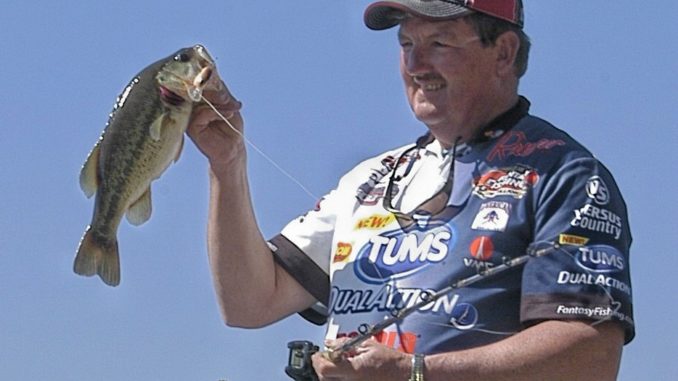
It didn’t take David Fritts and 11-year-old son, Thomas, long to figure out bass fishing at High Rock Lake following recent spring downpours was pretty much of a “wash” at the main lake.
Fritts, who’d just returned last week from a FLW excursion to Table Rock Lake at Branson, Mo., needed some quality time with his son and found where the bass were biting, even though it took a day of searching and a few phone calls.
The first day he fished (March 19), Fritts’ home lake, at least the main body, was the color of cafe au lait. In fact, High Rock had several shades of coffee-with-cream color as tons of rainwater had poured into the Yadkin River, washing off upstream red-clay landscapes. Locals call this High Rock water condition “mud.”
The crankbait bite — in fact all bites — disappeared at the lake’s main body, just as it had during the 1994 Bassmasters Classic when sustained, silt-transporting rains floated away Fritts’ chance to win.
But Sunday (March 22) turned out to be a better day.
“Even though we had a front come through here and it was a sunny day with cool temperatures, we found bass in Flat Swamp Creek,” said Fritts, the only man with FLW and BASS championship trophies on his wall.
However, Fritts couldn’t access Flat Swamp from the main lake because the water level had risen so high his bass boat wouldn’t navigate underneath a railroad trestle at the creek mouth. So he motored to the launch behind the trestle.
“We caught about a dozen bass,” said Fritts, N.C.’s No. 1 bass pro via prize money and major titles.
Like any good angler, the crankbait king switched tactics, using shallow-diving and no-lip crankbaits, such as Speed Shads and Rat-L-Traps.
Most of the bass weighed 2 to 3 1/2 pounds.
“Daddy lost a nice one, though, probably 5 1/2 pounds,” his son said with a laugh.
“Yeah, I did,” Fritts said. “It was more like 7 1/2 pounds though. We caught most of ’em in 8 to 10 feet of water and less.”
The lesson for any lake in similar situations this spring — heavy rains followed by high, muddy water — is to head for shallow pockets with the clearest water.
A few weeks earlier, Joel Richardson, a bass pro from Kernersville, tried Belews Lake, a Duke Energy impoundment that remains a steady 60 degrees during winter because of hot water discharges from its steam plant.
Richardson had been catching bass with drop-shot rigs in 40- to 50-feet depths. But Duke Energy, trying to prevent major drawdown in case of another summer and fall drought, had pumped tons of dirty cold water out of the Dan River into the lake.
That water settled to the bottom of the lake and pushed cleaner, warmer water toward the shallows at backs of coves.
Anglers caught bass at Belews Lake, even after the influx of millions of gallons of river water, in 3 to 6 feet depths by using shallow divers and spinnerbaits.





Be the first to comment